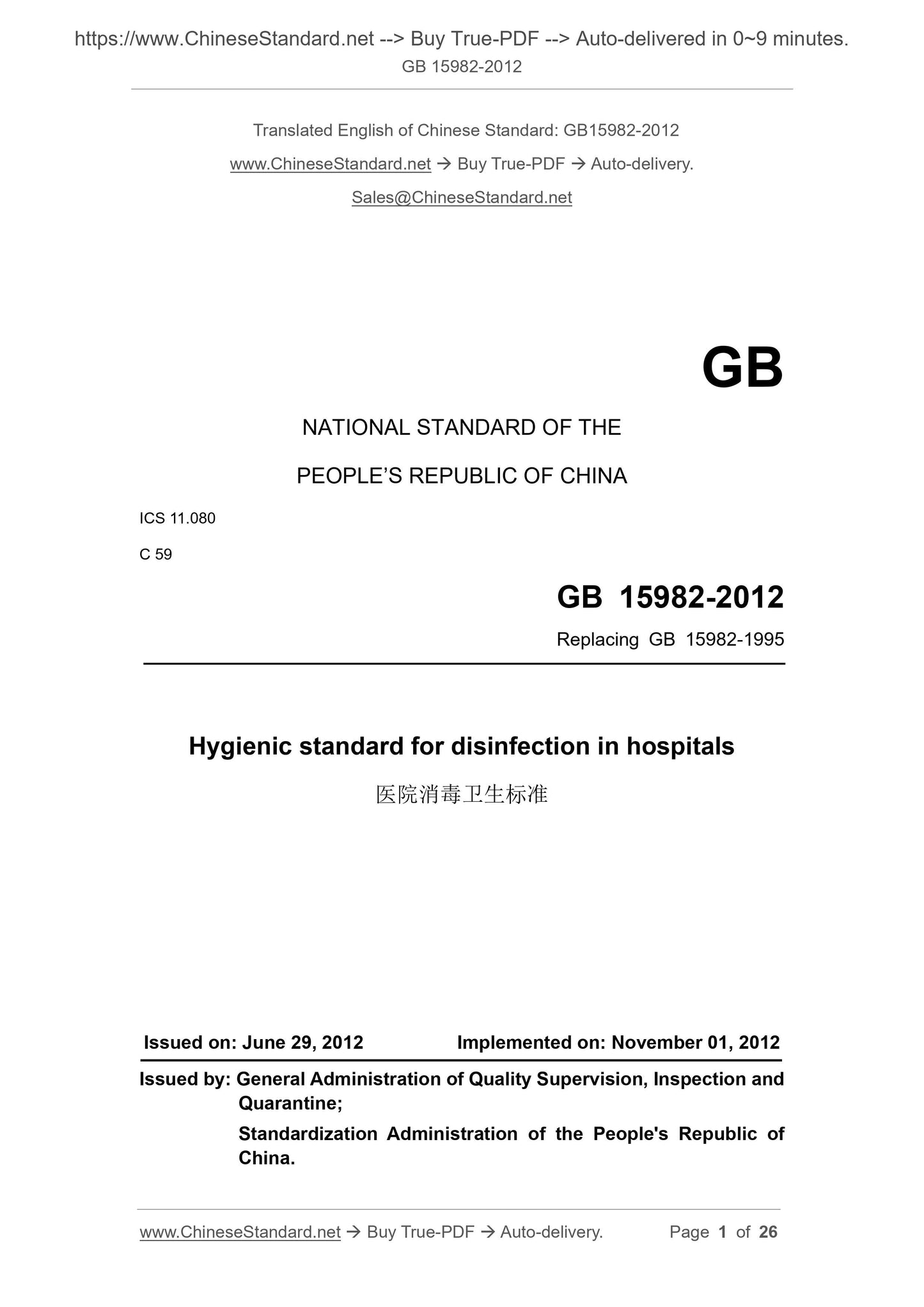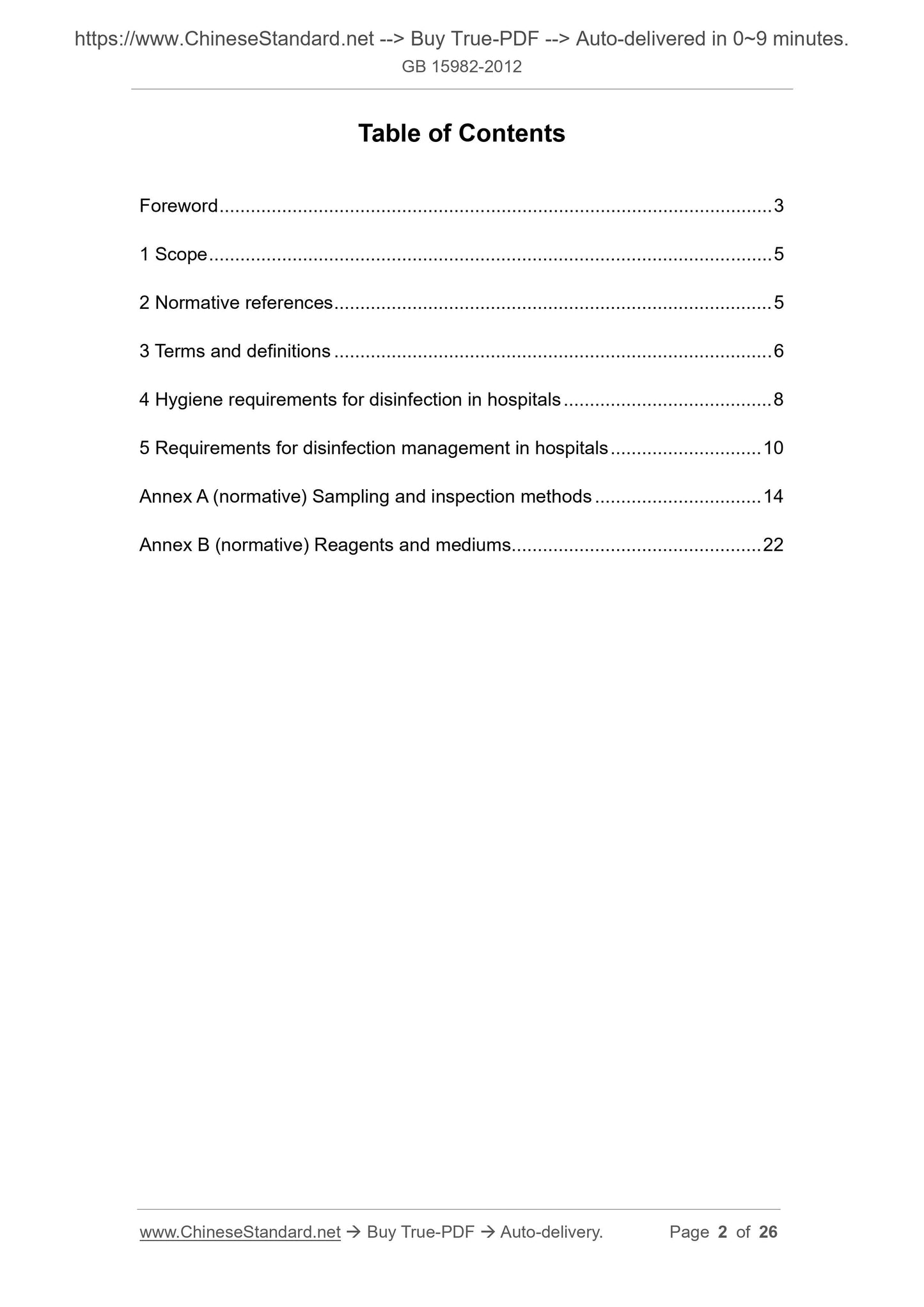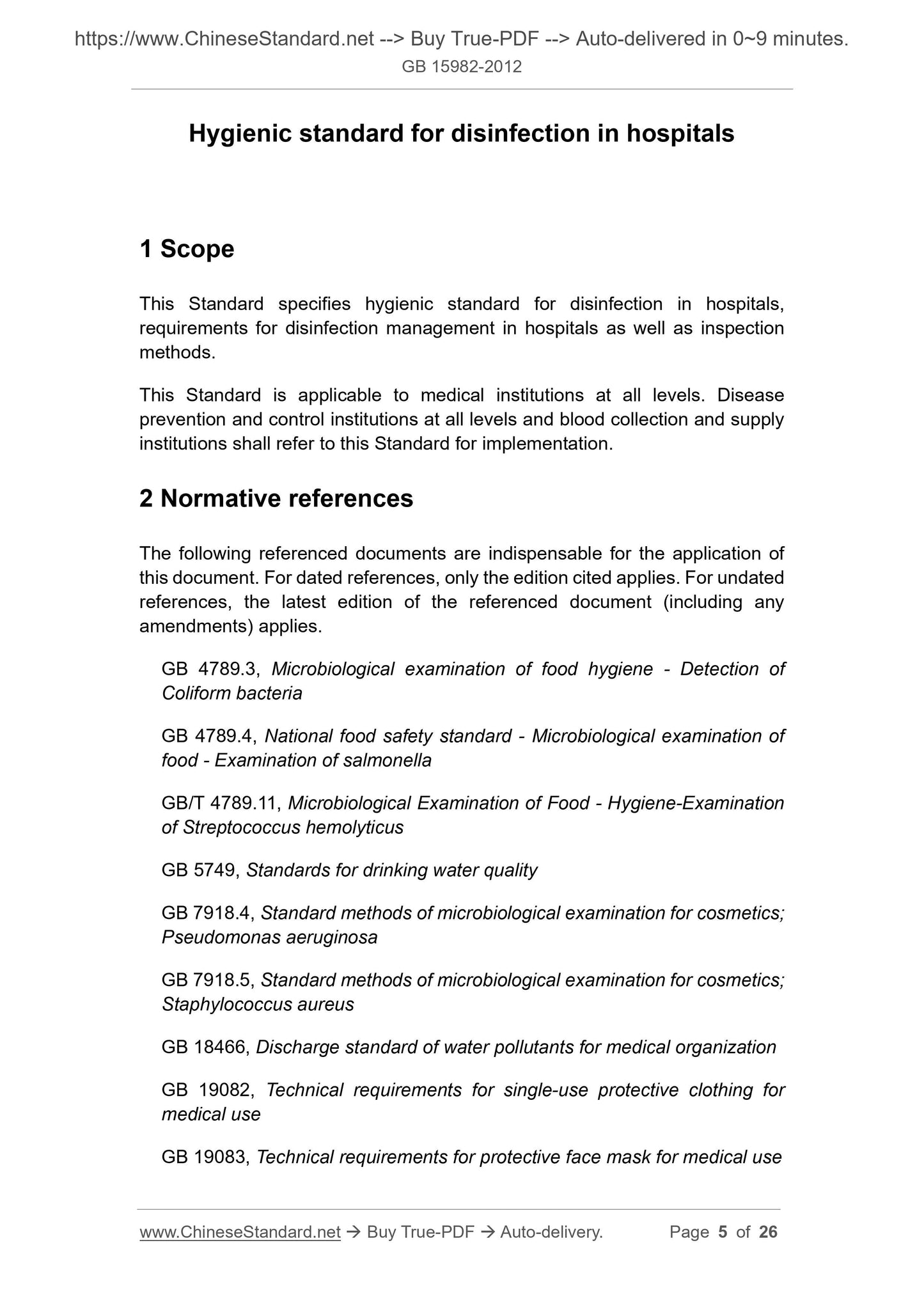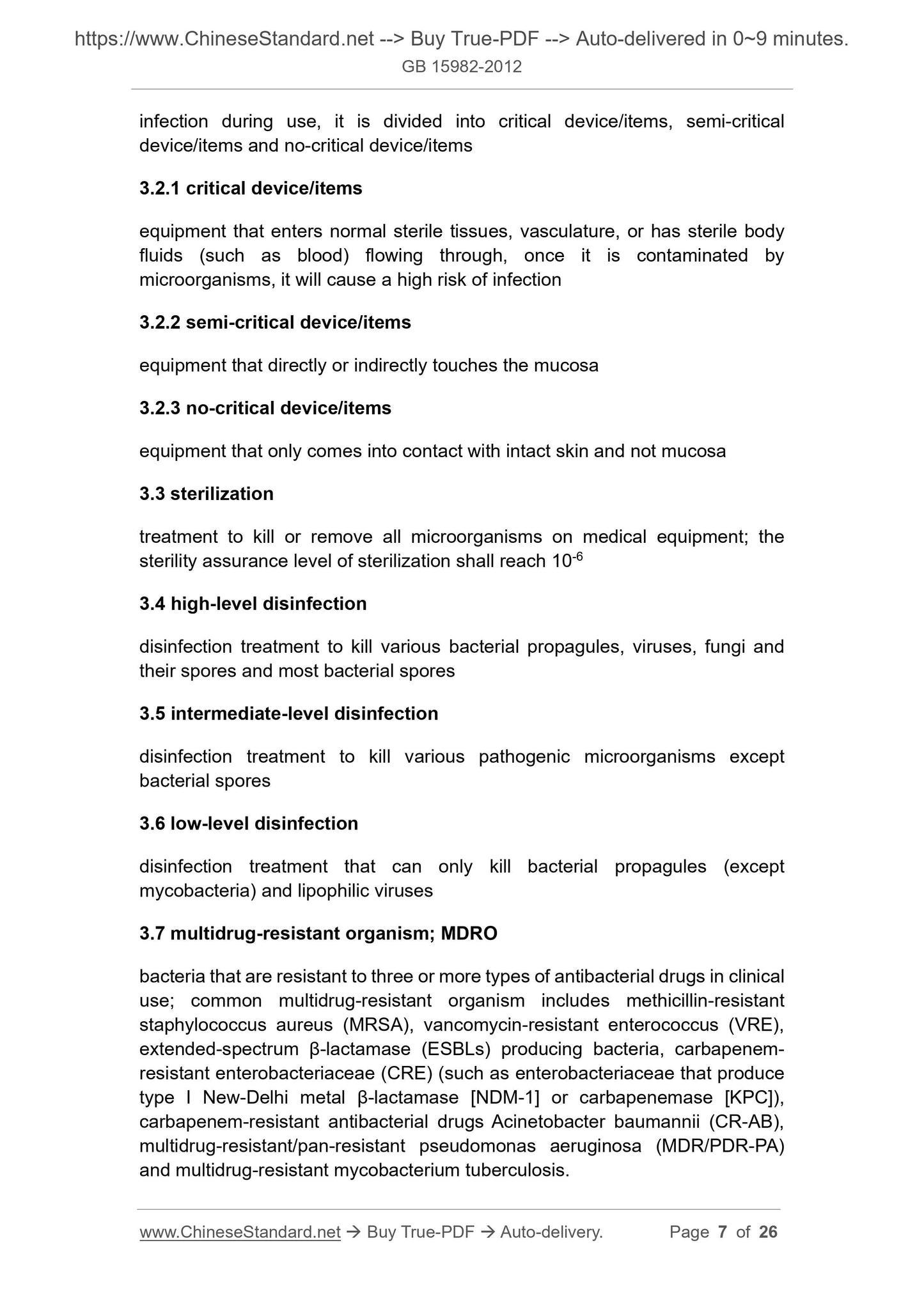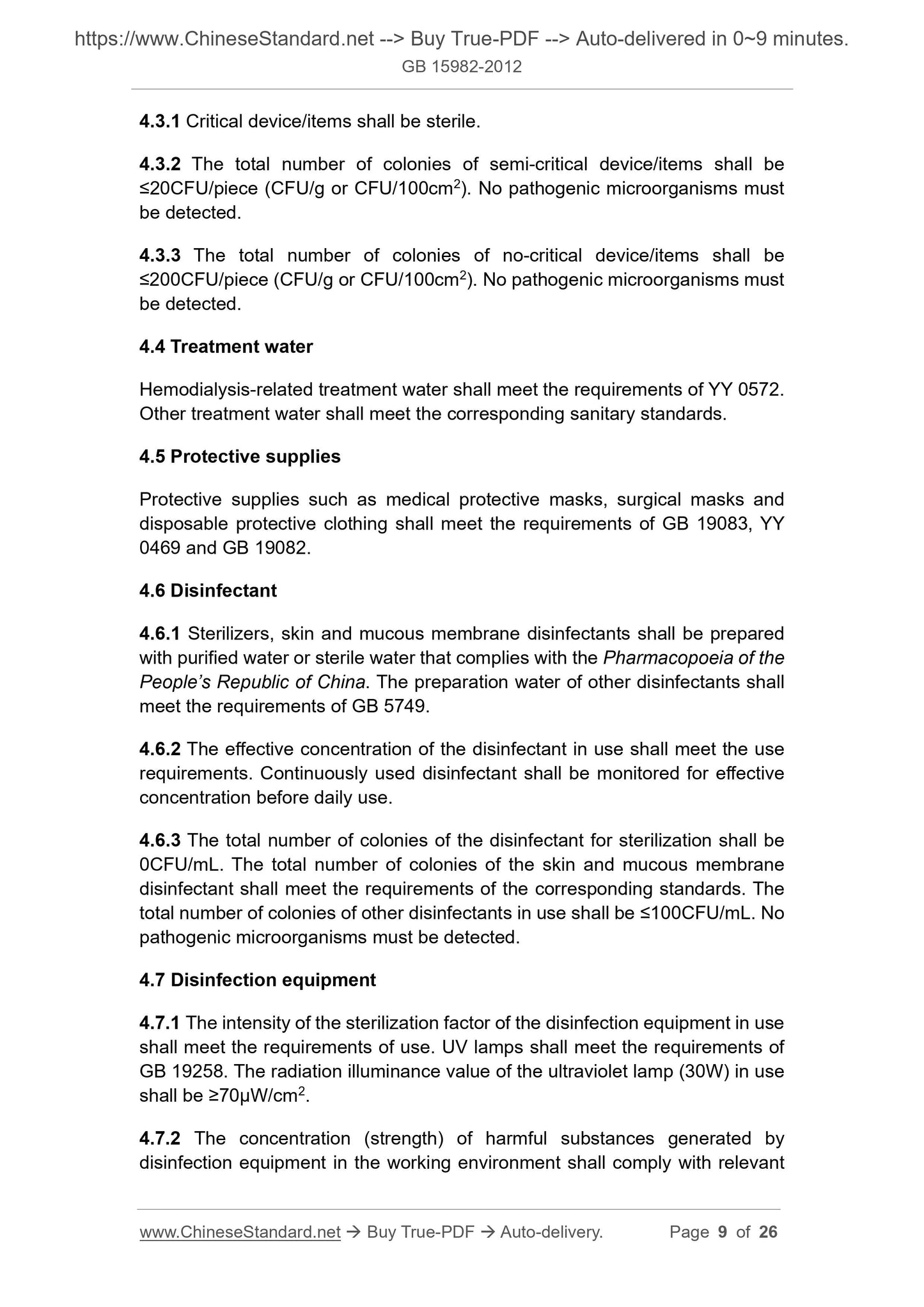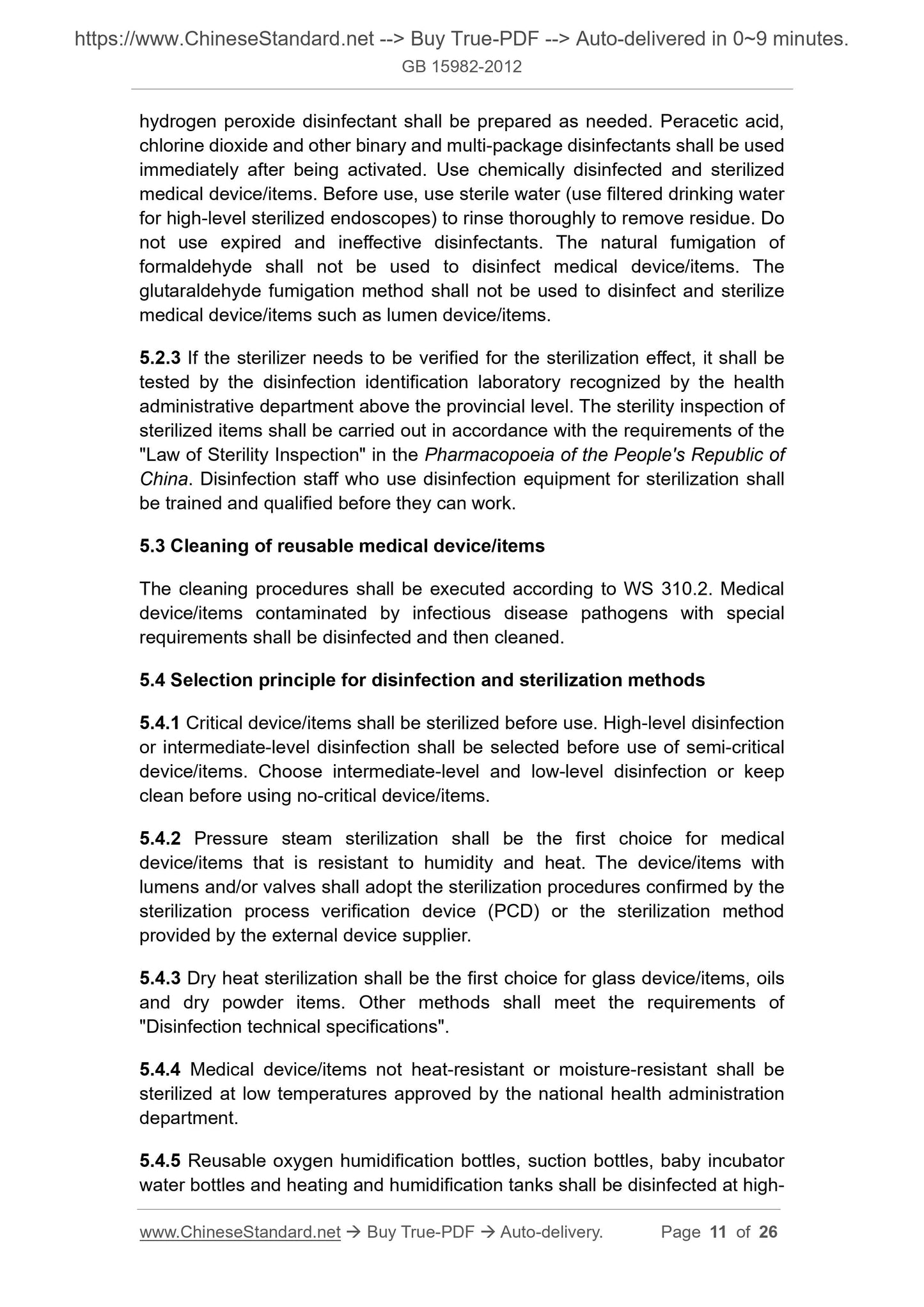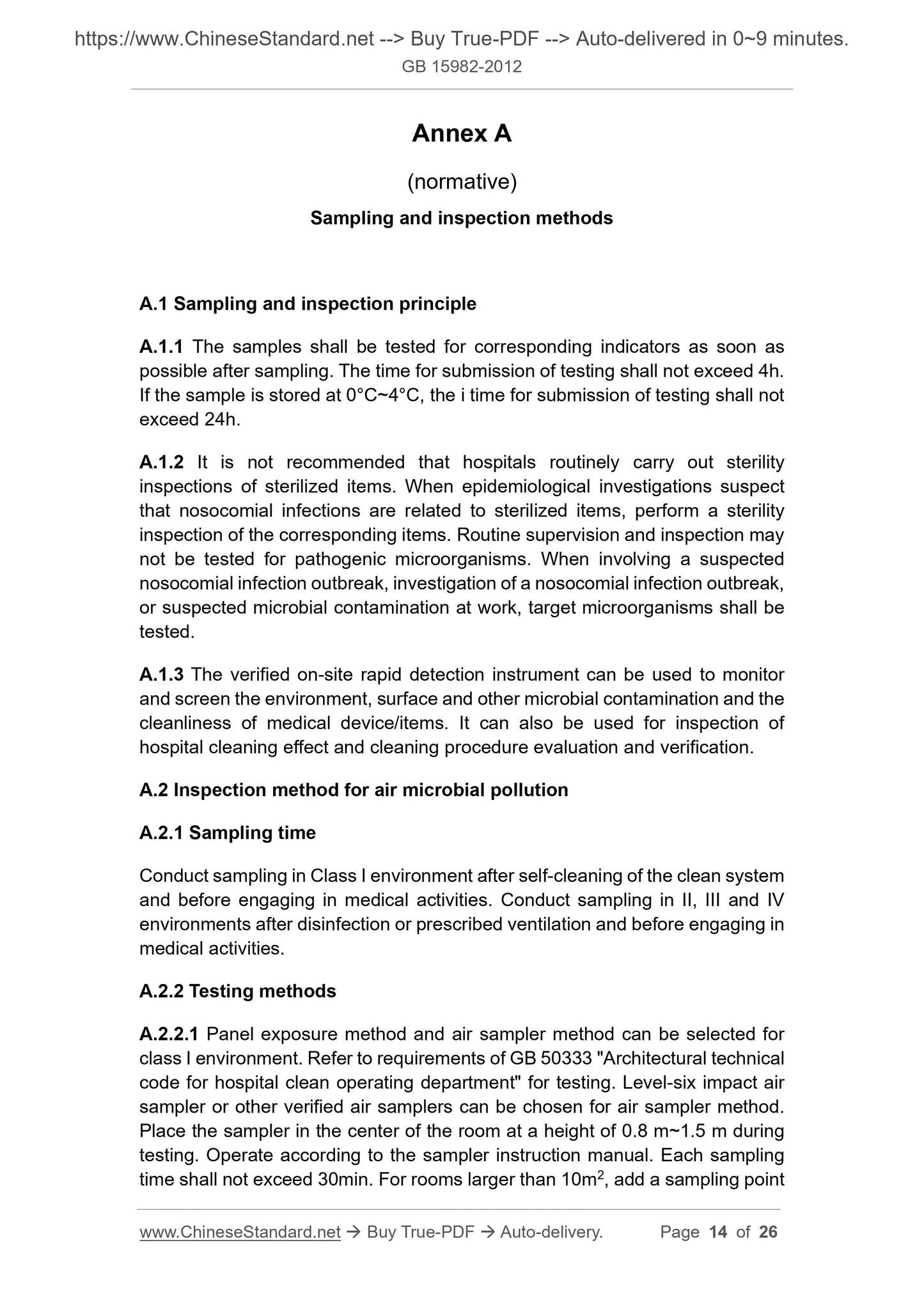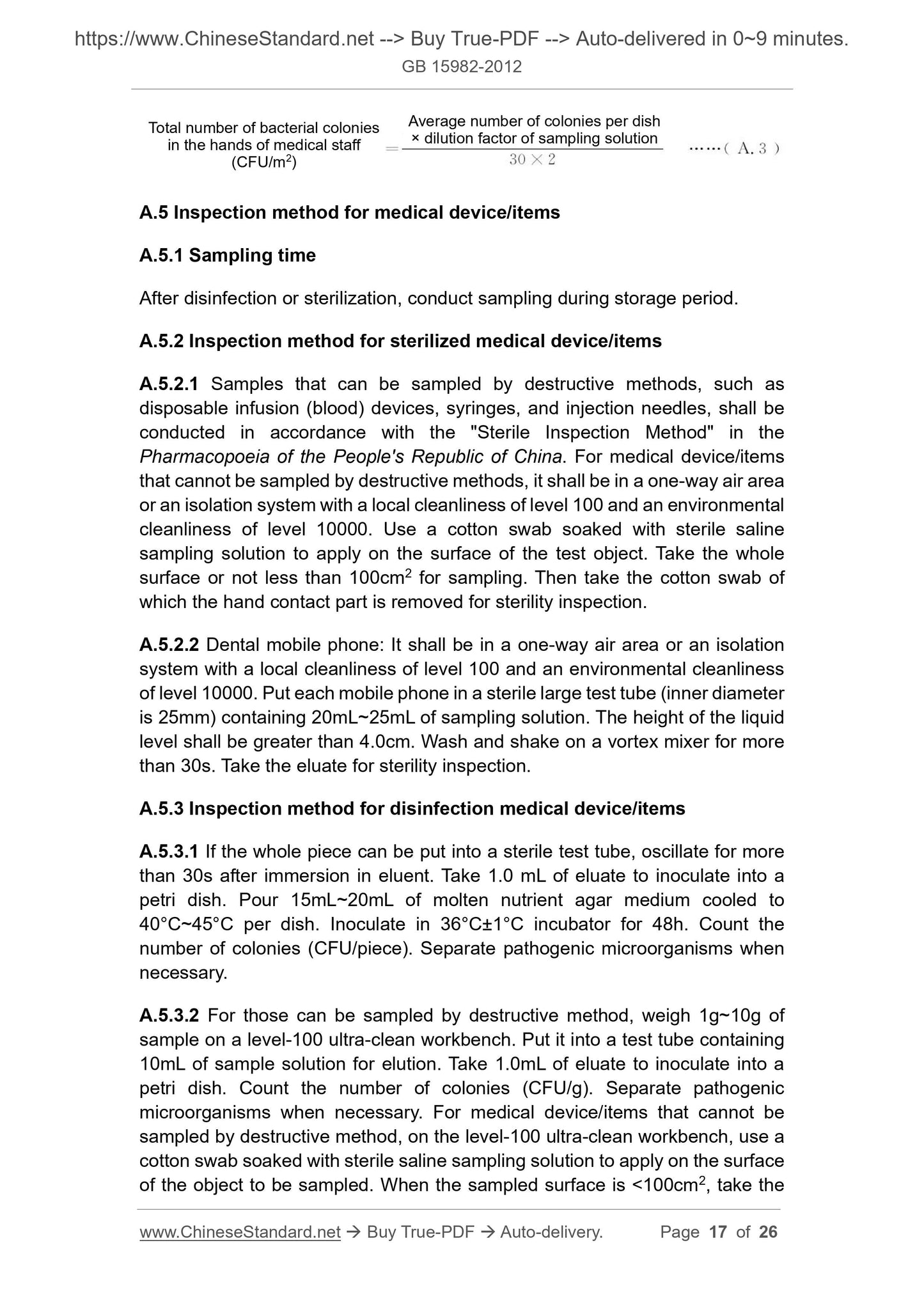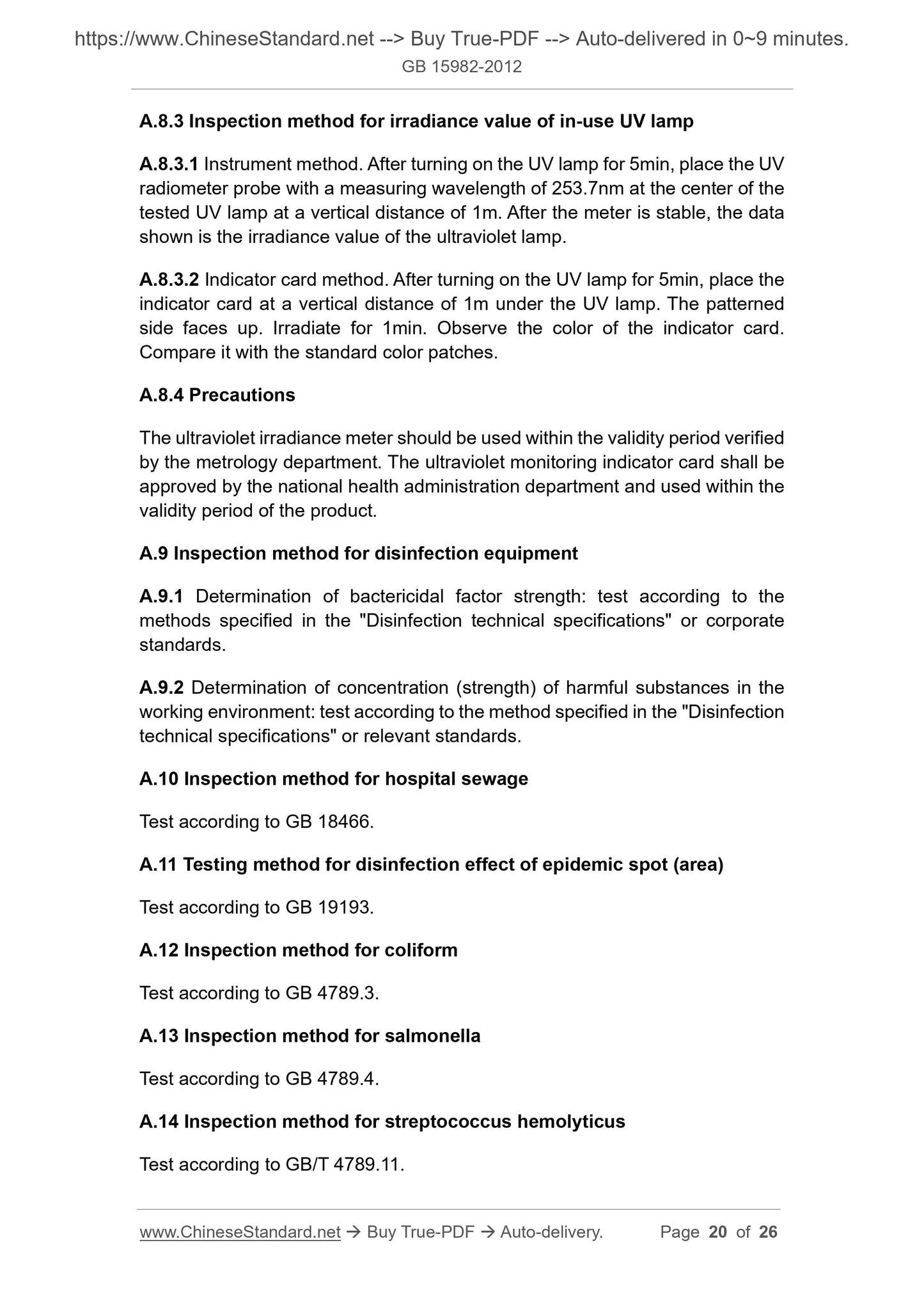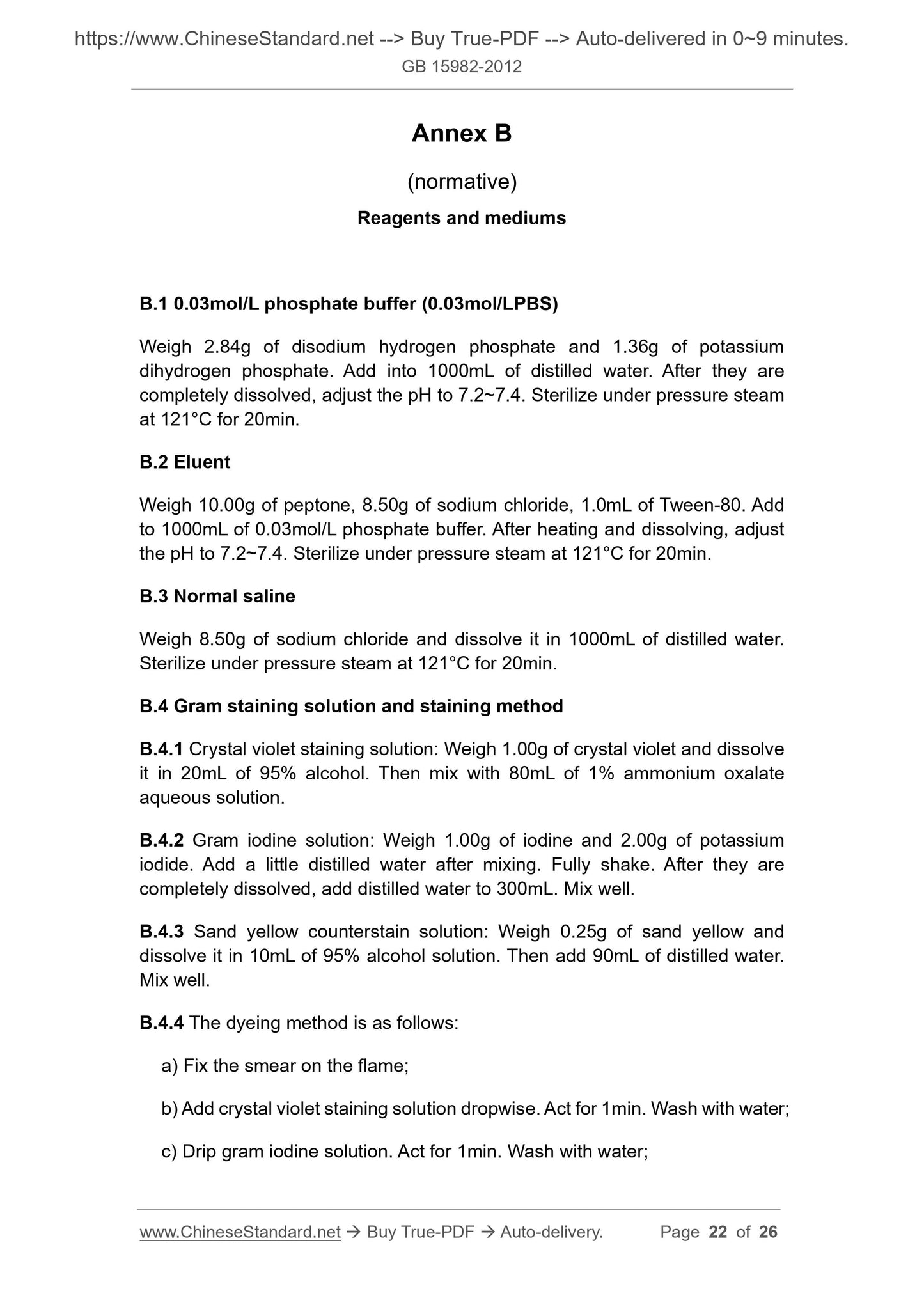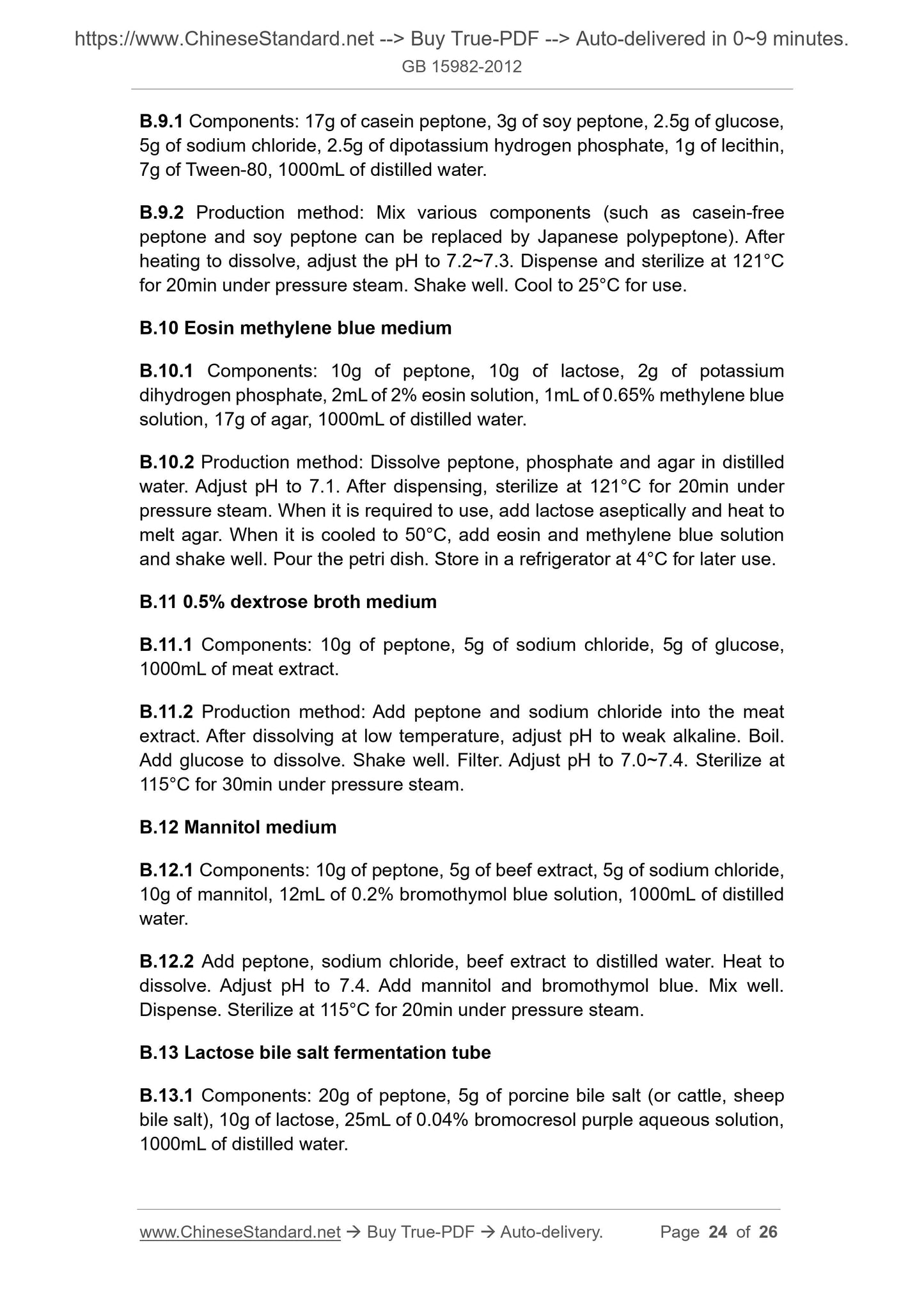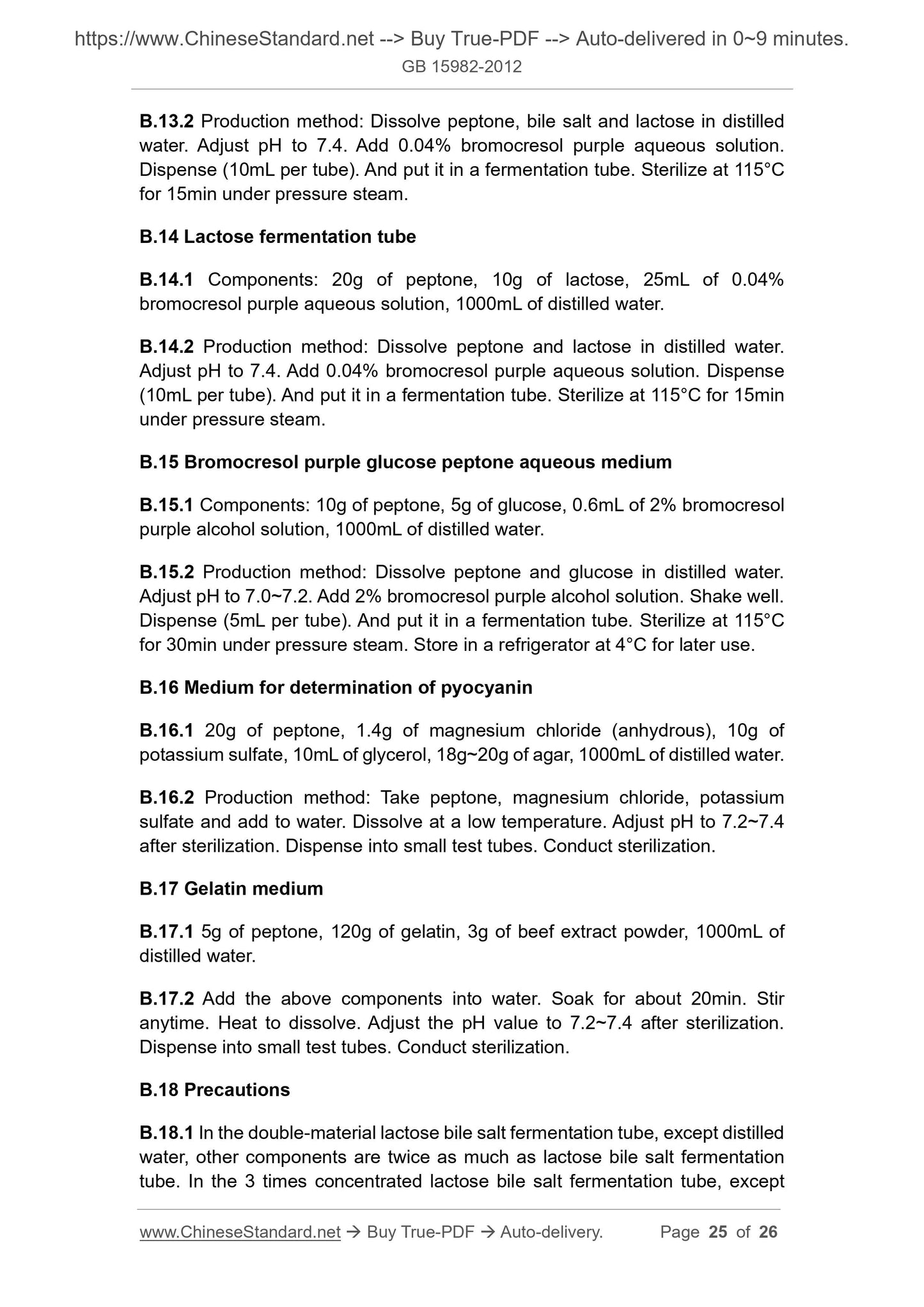1
/
of
12
PayPal, credit cards. Download editable-PDF & invoice in 1 second!
GB 15982-2012 English PDF (GB15982-2012)
GB 15982-2012 English PDF (GB15982-2012)
Regular price
$205.00 USD
Regular price
Sale price
$205.00 USD
Unit price
/
per
Shipping calculated at checkout.
Couldn't load pickup availability
Delivery: 3 seconds. Download true-PDF + Invoice.
Get QUOTATION in 1-minute: Click GB 15982-2012
Historical versions: GB 15982-2012
Preview True-PDF (Reload/Scroll if blank)
GB 15982-2012: Hygienic standard for disinfection in hospitals
GB 15982-2012
GB
NATIONAL STANDARD OF THE
PEOPLE’S REPUBLIC OF CHINA
ICS 11.080
C 59
Replacing GB 15982-1995
Hygienic standard for disinfection in hospitals
ISSUED ON: JUNE 29, 2012
IMPLEMENTED ON: NOVEMBER 01, 2012
Issued by: General Administration of Quality Supervision, Inspection and
Quarantine;
Standardization Administration of the People's Republic of
China.
Table of Contents
Foreword ... 3
1 Scope ... 5
2 Normative references ... 5
3 Terms and definitions ... 6
4 Hygiene requirements for disinfection in hospitals ... 8
5 Requirements for disinfection management in hospitals ... 10
Annex A (normative) Sampling and inspection methods ... 14
Annex B (normative) Reagents and mediums... 22
Hygienic standard for disinfection in hospitals
1 Scope
This Standard specifies hygienic standard for disinfection in hospitals,
requirements for disinfection management in hospitals as well as inspection
methods.
This Standard is applicable to medical institutions at all levels. Disease
prevention and control institutions at all levels and blood collection and supply
institutions shall refer to this Standard for implementation.
2 Normative references
The following referenced documents are indispensable for the application of
this document. For dated references, only the edition cited applies. For undated
references, the latest edition of the referenced document (including any
amendments) applies.
GB 4789.3, Microbiological examination of food hygiene - Detection of
Coliform bacteria
GB 4789.4, National food safety standard - Microbiological examination of
food - Examination of salmonella
GB/T 4789.11, Microbiological Examination of Food - Hygiene-Examination
of Streptococcus hemolyticus
GB 5749, Standards for drinking water quality
GB 7918.4, Standard methods of microbiological examination for cosmetics;
Pseudomonas aeruginosa
GB 7918.5, Standard methods of microbiological examination for cosmetics;
Staphylococcus aureus
GB 18466, Discharge standard of water pollutants for medical organization
GB 19082, Technical requirements for single-use protective clothing for
medical use
GB 19083, Technical requirements for protective face mask for medical use
infection during use, it is divided into critical device/items, semi-critical
device/items and no-critical device/items
3.2.1 critical device/items
equipment that enters normal sterile tissues, vasculature, or has sterile body
fluids (such as blood) flowing through, once it is contaminated by
microorganisms, it will cause a high risk of infection
3.2.2 semi-critical device/items
equipment that directly or indirectly touches the mucosa
3.2.3 no-critical device/items
equipment that only comes into contact with intact skin and not mucosa
3.3 sterilization
treatment to kill or remove all microorganisms on medical equipment; the
sterility assurance level of sterilization shall reach 10-6
3.4 high-level disinfection
disinfection treatment to kill various bacterial propagules, viruses, fungi and
their spores and most bacterial spores
3.5 intermediate-level disinfection
disinfection treatment to kill various pathogenic microorganisms except
bacterial spores
3.6 low-level disinfection
disinfection treatment that can only kill bacterial propagules (except
mycobacteria) and lipophilic viruses
3.7 multidrug-resistant organism; MDRO
bacteria that are resistant to three or more types of antibacterial drugs in clinical
use; common multidrug-resistant organism includes methicillin-resistant
staphylococcus aureus (MRSA), vancomycin-resistant enterococcus (VRE),
extended-spectrum β-lactamase (ESBLs) producing bacteria, carbapenem-
resistant enterobacteriaceae (CRE) (such as enterobacteriaceae that produce
type I New-Delhi metal β-lactamase [NDM-1] or carbapenemase [KPC]),
carbapenem-resistant antibacterial drugs Acinetobacter baumannii (CR-AB),
multidrug-resistant/pan-resistant pseudomonas aeruginosa (MDR/PDR-PA)
and multidrug-resistant mycobacterium tuberculosis.
4.3.1 Critical device/items shall be sterile.
4.3.2 The total number of colonies of semi-critical device/items shall be
≤20CFU/piece (CFU/g or CFU/100cm2). No pathogenic microorganisms must
be detected.
4.3.3 The total number of colonies of no-critical device/items shall be
≤200CFU/piece (CFU/g or CFU/100cm2). No pathogenic microorganisms must
be detected.
4.4 Treatment water
Hemodialysis-related treatment water shall meet the requirements of YY 0572.
Other treatment water shall meet the corresponding sanitary standards.
4.5 Protective supplies
Protective supplies such as medical protective masks, surgical masks and
disposable protective clothing shall meet the requirements of GB 19083, YY
0469 and GB 19082.
4.6 Disinfectant
4.6.1 Sterilizers, skin and mucous membrane disinfectants shall be prepared
with purified water or sterile water that complies with the Pharmacopoeia of the
People’s Republic of China. The preparation water of other disinfectants shall
meet the requirements of GB 5749.
4.6.2 The effective concentration of the disinfectant in use shall meet the use
requirements. Continuously used disinfectant shall be monitored for effective
concentration before daily use.
4.6.3 The total number of colonies of the disinfectant for sterilization shall be
0CFU/mL. The total number of colonies of the skin and mucous membrane
disinfectant shall meet the requirements of the corresponding standards. The
total number of colonies of other disinfectants in use shall be ≤100CFU/mL. No
pathogenic microorganisms must be detected.
4.7 Disinfection equipment
4.7.1 The intensity of the sterilization factor of the disinfection equipment in use
shall meet the requirements of use. UV lamps shall meet the requirements of
GB 19258. The radiation illuminance value of the ultraviolet lamp (30W) in use
shall be ≥70µW/cm2.
4.7.2 The concentration (strength) of harmful substances generated by
disinfection equipment in the working environment shall comply with relevant
hydrogen peroxide disinfectant shall be prepared as needed. Peracetic acid,
chlorine dioxide and other binary and multi-package disinfectants shall be used
immediately after being activated. Use chemically disinfected and sterilized
medical device/items. Before use, use sterile water (use filtered drinking water
for high-level sterilized endoscopes) to rinse thoroughly to remove residue. Do
not use expired and ineffective disinfectants. The natural fumigation of
formaldehyde shall not be used to disinfect medical device/items. The
glutaraldehyde fumigation method shall not be used to disinfect and sterilize
medical device/items such as lumen device/items.
5.2.3 If the sterilizer needs to be verified for the sterilization effect, it shall be
tested by the disinfection identification laboratory recognized by the health
administrative department above the provincial level. The sterility inspection of
sterilized items shall be carried out in accordance with the requirements of the
"Law of Sterility Inspection" in the Pharmacopoeia of the People's Republic of
China. Disinfection staff who use disinfection equipment for sterilization shall
be trained and qualified before they can work.
5.3 Cleaning of reusable medical device/items
The cleaning procedures shall be executed according to WS 310.2. Medical
device/items contaminated by infectious disease pathogens with spe...
Get QUOTATION in 1-minute: Click GB 15982-2012
Historical versions: GB 15982-2012
Preview True-PDF (Reload/Scroll if blank)
GB 15982-2012: Hygienic standard for disinfection in hospitals
GB 15982-2012
GB
NATIONAL STANDARD OF THE
PEOPLE’S REPUBLIC OF CHINA
ICS 11.080
C 59
Replacing GB 15982-1995
Hygienic standard for disinfection in hospitals
ISSUED ON: JUNE 29, 2012
IMPLEMENTED ON: NOVEMBER 01, 2012
Issued by: General Administration of Quality Supervision, Inspection and
Quarantine;
Standardization Administration of the People's Republic of
China.
Table of Contents
Foreword ... 3
1 Scope ... 5
2 Normative references ... 5
3 Terms and definitions ... 6
4 Hygiene requirements for disinfection in hospitals ... 8
5 Requirements for disinfection management in hospitals ... 10
Annex A (normative) Sampling and inspection methods ... 14
Annex B (normative) Reagents and mediums... 22
Hygienic standard for disinfection in hospitals
1 Scope
This Standard specifies hygienic standard for disinfection in hospitals,
requirements for disinfection management in hospitals as well as inspection
methods.
This Standard is applicable to medical institutions at all levels. Disease
prevention and control institutions at all levels and blood collection and supply
institutions shall refer to this Standard for implementation.
2 Normative references
The following referenced documents are indispensable for the application of
this document. For dated references, only the edition cited applies. For undated
references, the latest edition of the referenced document (including any
amendments) applies.
GB 4789.3, Microbiological examination of food hygiene - Detection of
Coliform bacteria
GB 4789.4, National food safety standard - Microbiological examination of
food - Examination of salmonella
GB/T 4789.11, Microbiological Examination of Food - Hygiene-Examination
of Streptococcus hemolyticus
GB 5749, Standards for drinking water quality
GB 7918.4, Standard methods of microbiological examination for cosmetics;
Pseudomonas aeruginosa
GB 7918.5, Standard methods of microbiological examination for cosmetics;
Staphylococcus aureus
GB 18466, Discharge standard of water pollutants for medical organization
GB 19082, Technical requirements for single-use protective clothing for
medical use
GB 19083, Technical requirements for protective face mask for medical use
infection during use, it is divided into critical device/items, semi-critical
device/items and no-critical device/items
3.2.1 critical device/items
equipment that enters normal sterile tissues, vasculature, or has sterile body
fluids (such as blood) flowing through, once it is contaminated by
microorganisms, it will cause a high risk of infection
3.2.2 semi-critical device/items
equipment that directly or indirectly touches the mucosa
3.2.3 no-critical device/items
equipment that only comes into contact with intact skin and not mucosa
3.3 sterilization
treatment to kill or remove all microorganisms on medical equipment; the
sterility assurance level of sterilization shall reach 10-6
3.4 high-level disinfection
disinfection treatment to kill various bacterial propagules, viruses, fungi and
their spores and most bacterial spores
3.5 intermediate-level disinfection
disinfection treatment to kill various pathogenic microorganisms except
bacterial spores
3.6 low-level disinfection
disinfection treatment that can only kill bacterial propagules (except
mycobacteria) and lipophilic viruses
3.7 multidrug-resistant organism; MDRO
bacteria that are resistant to three or more types of antibacterial drugs in clinical
use; common multidrug-resistant organism includes methicillin-resistant
staphylococcus aureus (MRSA), vancomycin-resistant enterococcus (VRE),
extended-spectrum β-lactamase (ESBLs) producing bacteria, carbapenem-
resistant enterobacteriaceae (CRE) (such as enterobacteriaceae that produce
type I New-Delhi metal β-lactamase [NDM-1] or carbapenemase [KPC]),
carbapenem-resistant antibacterial drugs Acinetobacter baumannii (CR-AB),
multidrug-resistant/pan-resistant pseudomonas aeruginosa (MDR/PDR-PA)
and multidrug-resistant mycobacterium tuberculosis.
4.3.1 Critical device/items shall be sterile.
4.3.2 The total number of colonies of semi-critical device/items shall be
≤20CFU/piece (CFU/g or CFU/100cm2). No pathogenic microorganisms must
be detected.
4.3.3 The total number of colonies of no-critical device/items shall be
≤200CFU/piece (CFU/g or CFU/100cm2). No pathogenic microorganisms must
be detected.
4.4 Treatment water
Hemodialysis-related treatment water shall meet the requirements of YY 0572.
Other treatment water shall meet the corresponding sanitary standards.
4.5 Protective supplies
Protective supplies such as medical protective masks, surgical masks and
disposable protective clothing shall meet the requirements of GB 19083, YY
0469 and GB 19082.
4.6 Disinfectant
4.6.1 Sterilizers, skin and mucous membrane disinfectants shall be prepared
with purified water or sterile water that complies with the Pharmacopoeia of the
People’s Republic of China. The preparation water of other disinfectants shall
meet the requirements of GB 5749.
4.6.2 The effective concentration of the disinfectant in use shall meet the use
requirements. Continuously used disinfectant shall be monitored for effective
concentration before daily use.
4.6.3 The total number of colonies of the disinfectant for sterilization shall be
0CFU/mL. The total number of colonies of the skin and mucous membrane
disinfectant shall meet the requirements of the corresponding standards. The
total number of colonies of other disinfectants in use shall be ≤100CFU/mL. No
pathogenic microorganisms must be detected.
4.7 Disinfection equipment
4.7.1 The intensity of the sterilization factor of the disinfection equipment in use
shall meet the requirements of use. UV lamps shall meet the requirements of
GB 19258. The radiation illuminance value of the ultraviolet lamp (30W) in use
shall be ≥70µW/cm2.
4.7.2 The concentration (strength) of harmful substances generated by
disinfection equipment in the working environment shall comply with relevant
hydrogen peroxide disinfectant shall be prepared as needed. Peracetic acid,
chlorine dioxide and other binary and multi-package disinfectants shall be used
immediately after being activated. Use chemically disinfected and sterilized
medical device/items. Before use, use sterile water (use filtered drinking water
for high-level sterilized endoscopes) to rinse thoroughly to remove residue. Do
not use expired and ineffective disinfectants. The natural fumigation of
formaldehyde shall not be used to disinfect medical device/items. The
glutaraldehyde fumigation method shall not be used to disinfect and sterilize
medical device/items such as lumen device/items.
5.2.3 If the sterilizer needs to be verified for the sterilization effect, it shall be
tested by the disinfection identification laboratory recognized by the health
administrative department above the provincial level. The sterility inspection of
sterilized items shall be carried out in accordance with the requirements of the
"Law of Sterility Inspection" in the Pharmacopoeia of the People's Republic of
China. Disinfection staff who use disinfection equipment for sterilization shall
be trained and qualified before they can work.
5.3 Cleaning of reusable medical device/items
The cleaning procedures shall be executed according to WS 310.2. Medical
device/items contaminated by infectious disease pathogens with spe...
Share
